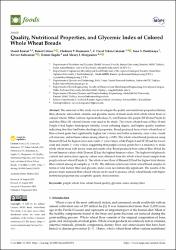| dc.contributor.author | Koksel, Hamit | |
| dc.contributor.author | Cetiner, Buket | |
| dc.contributor.author | Shamanin, Vladimir P. | |
| dc.contributor.author | Tekin-Cakmak, Z. Hazal | |
| dc.contributor.author | Pototskaya, Inna V. | |
| dc.contributor.author | Kahraman, Kevser | |
| dc.contributor.author | Sagdic, Osman | |
| dc.contributor.author | Morgounov, Alexey I. | |
| dc.date.accessioned | 2024-02-13T10:49:56Z | |
| dc.date.available | 2024-02-13T10:49:56Z | |
| dc.date.issued | 2023 | en_US |
| dc.identifier.issn | 2304-8158 | |
| dc.identifier.other | WOS:001073590800001 | |
| dc.identifier.uri | https://doi.org/10.3390/foods12183376 | |
| dc.identifier.uri | https://hdl.handle.net/20.500.12573/1936 | |
| dc.description.abstract | The main aim of this study was to investigate the quality and nutritional properties (dietary
fiber, phenolic, antioxidant contents, and glycemic index) of breads made from whole wheat flours of
colored wheats. White (cultivar Agronomicheskaya 5), red (Element 22), purple (EF 22 and Purple 8),
and blue (Blue 10) colored wheats were used in the study. The whole wheat flours of Blue 10 and
Purple 8 had higher farinograph stability, lower softening degree, and higher quality numbers
indicating that they had better rheological properties. Bread produced from whole wheat flour of
blue-colored grain had significantly higher loaf volume and better symmetry, crust color, crumb
cell structure, and softness values among others (p < 0.05). The whole wheat bread produced using
Element 22 had the highest crust and crumb L* color values, while Purple 8 and EF 22 had the lowest
crust and crumb L* color values, suggesting that purple-colored grains have a tendency to make
whole wheat bread with darker crust and crumb color. Bread produced from cultivar Blue 10 had the
lowest firmness values while Element 22 had the highest firmness values. The highest total phenolic
content and antioxidant capacity values were obtained from the whole wheat bread sample from
purple-colored wheat (Purple 8). The whole wheat flour of Element 22 had the highest total dietary
fiber content among all samples (p < 0.05). The differences between whole wheat bread samples in
terms of total dietary fiber and glycemic index were not statistically significant. The results of the
present study indicated that colored wheats can be used to produce whole wheat breads with higher
nutritional properties and acceptable quality characteristics. | en_US |
| dc.description.sponsorship | The authors would like to thank the Field Crops Central Research Institute for technical support. | en_US |
| dc.language.iso | eng | en_US |
| dc.publisher | MDPI | en_US |
| dc.relation.isversionof | 10.3390/foods12183376 | en_US |
| dc.rights | info:eu-repo/semantics/openAccess | en_US |
| dc.subject | purple wheat | en_US |
| dc.subject | blue wheat | en_US |
| dc.subject | bread quality | en_US |
| dc.subject | glycemic index | en_US |
| dc.subject | dietary fiber | en_US |
| dc.title | Quality, Nutritional Properties, and Glycemic Index of Colored Whole Wheat Breads | en_US |
| dc.type | article | en_US |
| dc.contributor.department | AGÜ, Mühendislik Fakültesi, Malzeme Bilimi ve Nanoteknoloji Mühendisliği Bölümü | en_US |
| dc.contributor.authorID | 0000-0002-2786-3944 | en_US |
| dc.contributor.institutionauthor | Kahraman, Kevser | |
| dc.identifier.volume | 12 | en_US |
| dc.identifier.issue | 18 | en_US |
| dc.identifier.startpage | 1 | en_US |
| dc.identifier.endpage | 13 | en_US |
| dc.relation.journal | FOODS | en_US |
| dc.relation.publicationcategory | Makale - Uluslararası Hakemli Dergi - Kurum Öğretim Elemanı | en_US |


















